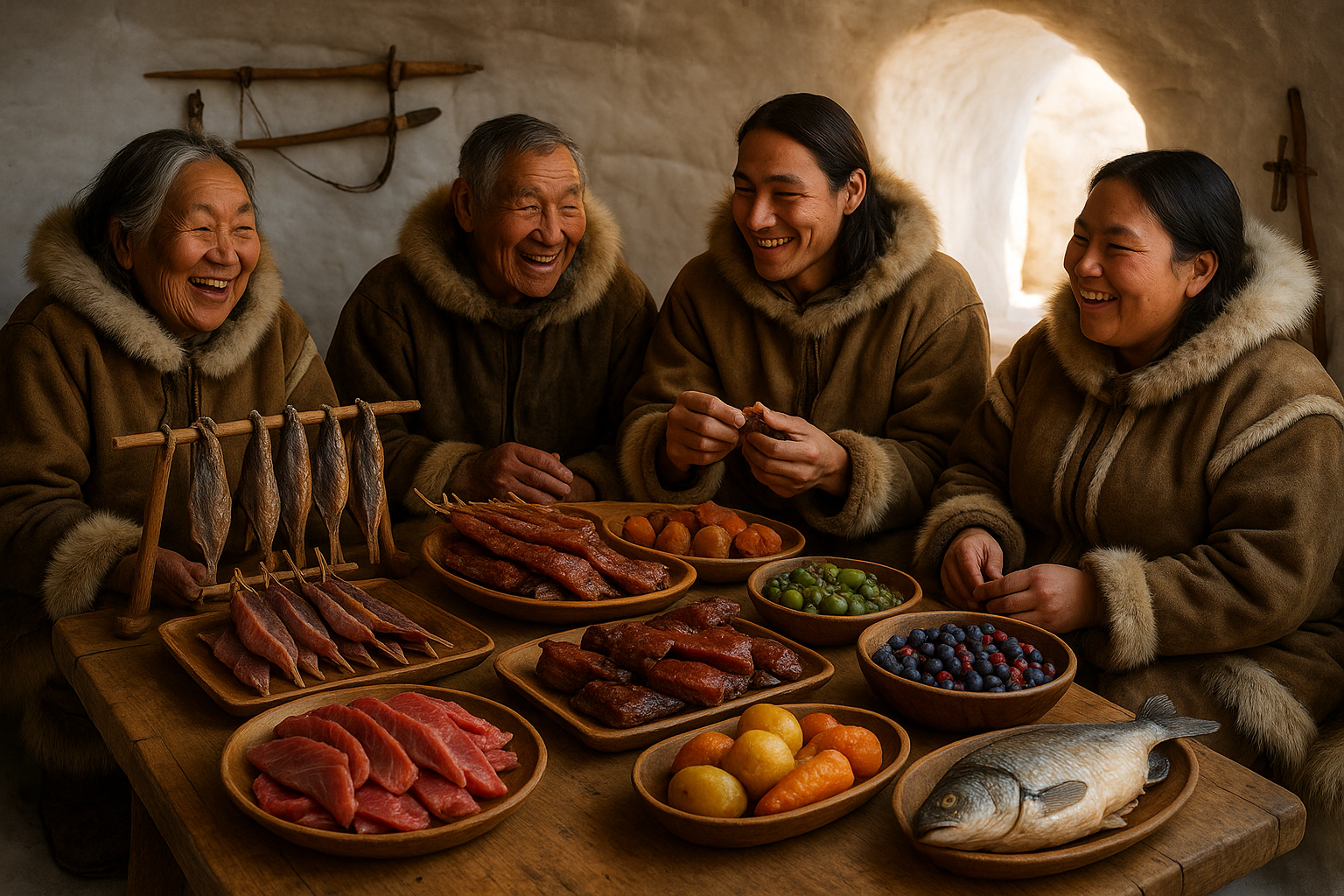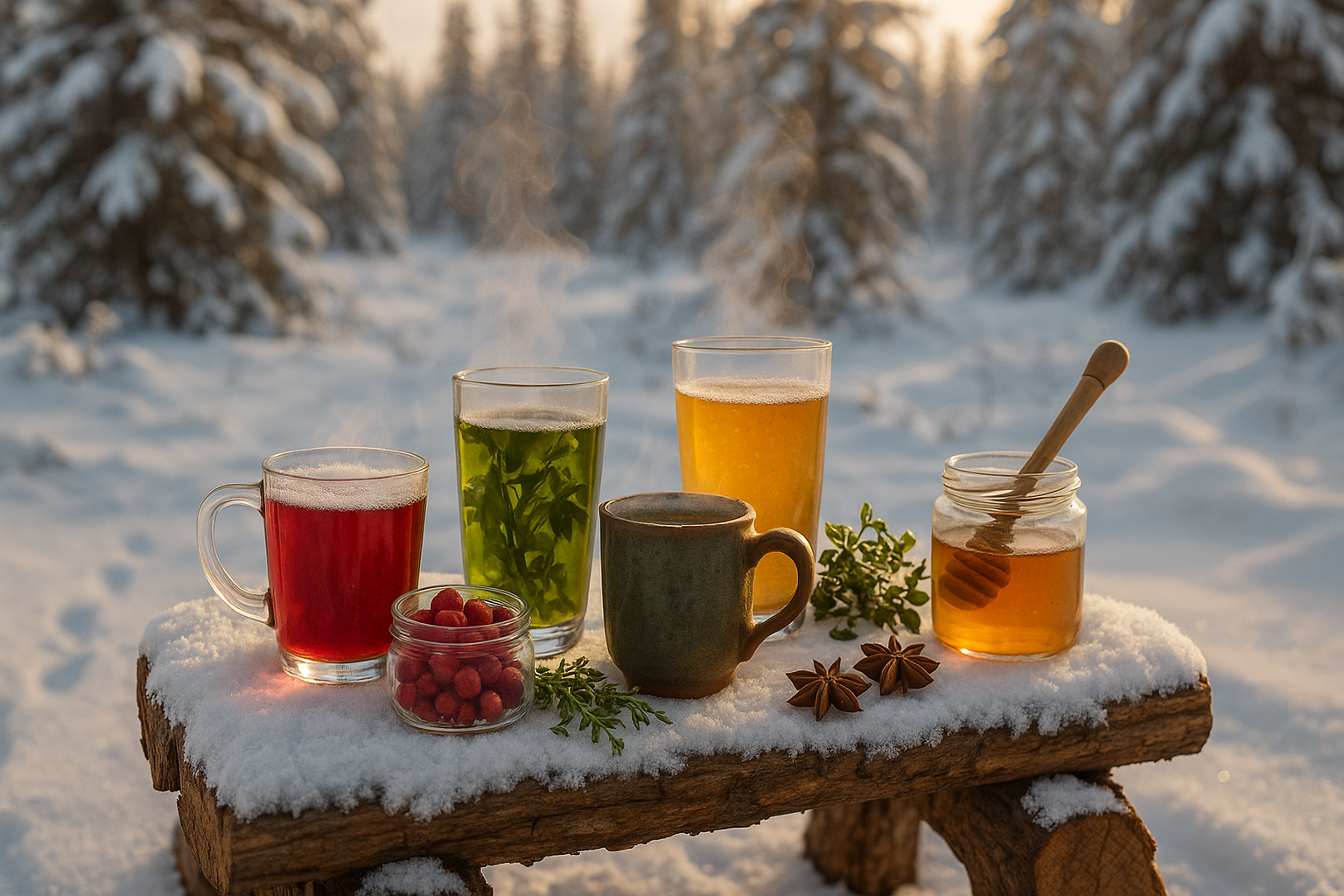Amidst the expansive icy landscapes and the mesmerizing dance of the northern lights, there lies a culinary tradition that is as rich and fascinating as the Arctic itself. The Inuit people, resilient inhabitants of this frigid paradise, have mastered the art of creating sumptuous feasts using the seasonal bounty of their environment. This article delves into the heart of these culinary traditions, exploring how Inuit communities transform simple, local ingredients into nourishing and celebratory meals that warm both body and soul. 🌌
Imagine sitting at a communal table, surrounded by Inuit families sharing stories as they pass around dishes crafted from the freshest catches of the season. From the iconic seal meat to the delightful Arctic char, each bite is a testament to the Inuit’s deep connection with their land and waters. These feasts are not just about sustenance; they are about survival, celebration, and community. In a land where resources are scarce and the climate is unforgiving, the Inuit have developed a profound respect for their food sources, ensuring that nothing goes to waste.
In this exploration of Arctic culinary traditions, we will uncover the secrets behind the Inuit’s remarkable ability to thrive in harmony with nature. We’ll start by examining the seasonal foods that form the backbone of Inuit feasts. Each season brings a new array of ingredients, from the berries that burst forth in the brief Arctic summer to the hearty game that sustains during the long winter months. Understanding these seasonal cycles is crucial to appreciating the ingenuity of Inuit cuisine.
Next, we’ll delve into the traditional methods of food preparation and preservation that have been passed down through generations. The Inuit have honed techniques that allow them to store and savor the flavors of each season, ensuring their communities remain nourished year-round. We’ll explore methods like fermenting, drying, and smoking, each contributing to the unique taste profiles that define Inuit dishes.
Of course, no exploration of Inuit feasts would be complete without highlighting the communal aspect of these gatherings. Feasting is an essential social activity, strengthening bonds and fostering a sense of unity among community members. We’ll discuss how these events are organized and the cultural significance they hold, not only as a means of sharing food but as a way to celebrate heritage and identity. 🥳
Additionally, we’ll consider the influence of modernity on these age-old traditions. As globalization reaches even the remote corners of the Arctic, Inuit cuisine is evolving. New ingredients and cooking techniques are being incorporated, blending the old with the new in delightful and unexpected ways. We’ll explore the challenges and opportunities this presents for preserving traditional practices while embracing innovation.
Throughout this article, you’ll gain insights into the vibrant world of Inuit culinary arts. By the end, you’ll have a newfound appreciation for how these communities have turned the often harsh realities of Arctic life into a celebration of resilience and flavor. Whether you’re a food enthusiast, a cultural explorer, or someone simply curious about life in the Arctic, there’s something here to captivate your senses and broaden your understanding.
So, prepare to embark on a journey through the tastes and traditions of the Arctic, where every meal tells a story and every flavor is a testament to human ingenuity. Welcome to the world of Inuit feasts—a place where the past and present merge in a delightful dance of culinary delight. 🍽️
# Arctic Delights: Exploring the Culinary Traditions of Inuit Feasts with Seasonal Foods
## Unveiling the Rich Tapestry of Inuit Culinary Traditions
The Inuit people, indigenous to the Arctic regions, possess a culinary tradition that is as rich and vibrant as the icy landscapes they inhabit. With a deep respect for the land and its seasonal offerings, the Inuit have developed a diet that not only sustains them in harsh climates but also celebrates the bounty of nature. This exploration into their culinary traditions reveals a culture deeply intertwined with its environment, where every meal is a testament to survival, community, and respect for the natural world.
Inuit feasts are a communal affair, often marking significant events or seasonal changes. These gatherings are not merely about sustenance but are a celebration of life and community, with food playing a central role. The dishes served are a reflection of the seasons, with ingredients sourced directly from the land and sea. This reliance on seasonal foods not only ensures freshness but also honors the cycles of nature. It is an intricate dance with the environment, where the Inuit harness the natural abundance of their surroundings to create meals that are both nutritious and flavorful.
One of the cornerstones of Inuit culinary tradition is the use of every part of the animal. This practice is not only a testament to their resourcefulness but also a deep respect for the creatures that provide sustenance. From seal and caribou to fish and whale, each animal is utilized to its fullest, ensuring nothing goes to waste. This approach to cooking is both sustainable and deeply rooted in Inuit values, highlighting a harmonious relationship with nature that is integral to their way of life.
## The Art of Seasonal Eating: From Sea to Table
Inuit cuisine is inherently seasonal, with each dish telling the story of the land and sea. The frigid Arctic waters provide a bounty of seafood, which forms the backbone of the Inuit diet. Fish, such as Arctic char and salmon, are staples, often prepared in a variety of ways, from drying and smoking to fermenting and boiling. These methods not only preserve the fish but also enhance their natural flavors, creating a culinary experience that is both unique and satisfying.
The changing seasons also dictate the availability of certain foods, influencing the Inuit diet throughout the year. During the summer months, the melting ice allows for easier access to fishing grounds, resulting in an abundance of fresh fish and marine mammals. Conversely, the winter months are a time for hunting land animals, such as caribou and muskox, which are then preserved for the harsher months ahead. This cyclical approach to eating ensures that the Inuit not only survive but thrive in one of the most challenging environments on Earth.
Vegetation, although sparse in the Arctic, also plays a role in Inuit cuisine. Berries, roots, and edible plants are foraged during the short summer months and often preserved for later use. These plant-based foods add variety to the Inuit diet, providing essential vitamins and nutrients that complement the protein-rich meals derived from animal sources. This harmonious balance between land and sea is a testament to the ingenuity and adaptability of the Inuit people.
## Culinary Techniques: The Magic Behind Inuit Dishes
The preparation of Inuit dishes is an art form that has been perfected over generations. Traditional cooking methods not only preserve the nutritional value of the food but also infuse it with distinct flavors that are a hallmark of Inuit cuisine. One such method is the use of seal oil, a staple in many dishes. Rich in omega-3 fatty acids, seal oil is used as a condiment, adding depth and richness to a variety of meals. It is a versatile ingredient that exemplifies the resourcefulness of Inuit cooking.
Smoking is another popular technique, used to preserve fish and meat for the long winter months. This method imparts a smoky flavor that enhances the natural taste of the food, creating a delicacy that is both nutritious and flavorful. Similarly, fermenting is employed to preserve fish, a technique that not only extends its shelf life but also transforms its flavor profile. These traditional methods of preservation are a testament to the Inuit’s deep understanding of their environment and their ability to adapt to its challenges.
In recent years, there has been a resurgence of interest in Inuit cuisine, both within the Arctic communities and beyond. Chefs and culinary enthusiasts are increasingly exploring traditional Inuit ingredients and methods, adapting them to modern tastes while respecting their cultural significance. This renewed interest is a celebration of Inuit culinary heritage, ensuring that these traditions are preserved and passed down to future generations.
## The Role of Feasts in Inuit Society: More Than Just a Meal
Inuit feasts are more than just a culinary event; they are a cornerstone of Inuit culture and community life. These gatherings are an opportunity for storytelling, celebration, and strengthening of social bonds. Feasts often coincide with significant cultural events, such as the successful completion of a hunt, the changing of the seasons, or traditional ceremonies. They serve as a reminder of the interconnectedness of the community and the environment, highlighting the importance of collaboration and shared experiences.
At these feasts, food is a central element, with an emphasis on sharing and abundance. The dishes served are a showcase of Inuit culinary prowess, featuring a variety of seasonal ingredients prepared with traditional techniques. Each meal is a celebration of the land and sea, a testament to the resourcefulness and adaptability of the Inuit people. It is a communal affair, where everyone contributes, ensuring that the feast is a reflection of the community’s collective efforts and achievements.
These feasts also serve as an educational opportunity for younger generations, allowing them to learn about their cultural heritage and culinary traditions. Through participation in these events, they gain valuable knowledge about hunting, cooking, and the importance of sustainable living. This passing down of traditions ensures the preservation of Inuit culture and the continuation of their unique culinary practices.
## Embracing Modern Influences: The Evolution of Inuit Cuisine
While Inuit culinary traditions are deeply rooted in history, they are not immune to the influences of the modern world. Globalization and increased access to a variety of ingredients have introduced new flavors and techniques to Inuit cooking, leading to a fusion of traditional and contemporary styles. This evolution is a testament to the adaptability of the Inuit people, who have seamlessly integrated new elements into their culinary repertoire while maintaining the essence of their traditional dishes.
The introduction of modern cooking techniques and ingredients has expanded the possibilities for Inuit cuisine, allowing for greater creativity and experimentation. Chefs and home cooks alike are embracing this fusion of old and new, creating dishes that are both innovative and deeply respectful of their cultural heritage. This blending of traditions not only enhances the flavor and diversity of Inuit cuisine but also ensures its relevance in a rapidly changing world.
Despite these modern influences, the core values of Inuit cuisine remain unchanged. The emphasis on sustainability, respect for the environment, and the use of seasonal ingredients continues to be at the heart of Inuit cooking. This commitment to tradition ensures that, even as Inuit cuisine evolves, it remains a reflection of the culture and values of the Inuit people.
## Conclusion: A Culinary Journey Through the Arctic
Inuit culinary traditions offer a unique glimpse into a culture that is as resilient and adaptable as the Arctic itself. Through their innovative use of seasonal ingredients and traditional cooking methods, the Inuit have created a cuisine that is both sustainable and deeply connected to the natural world. It is a celebration of life and community, where every meal is a testament to the enduring spirit of the Inuit people.
As interest in indigenous cuisines continues to grow, Inuit culinary traditions stand as a beacon of sustainability and respect for the environment. They offer valuable lessons on living in harmony with nature, highlighting the importance of resourcefulness and adaptability in the face of adversity. Through their rich culinary heritage, the Inuit remind us of the power of food to bring people together, fostering a sense of community and shared purpose.
For those interested in exploring the rich tapestry of Inuit cuisine, consider watching the YouTube video titled “Traditional Inuit Foods and Their Preparation” by the channel “Indigenous Flavors”. This video provides an insightful look into the traditional methods and ingredients used in Inuit cooking, offering a deeper understanding of this fascinating culinary tradition.

Conclusion
Certainly! Here’s a detailed conclusion for your article on “Arctic Delights: Exploring the Culinary Traditions of Inuit Feasts with Seasonal Foods.”
Conclusion
The exploration of Arctic culinary traditions offers a fascinating glimpse into the resilience and creativity of the Inuit culture. This journey through the rich tapestry of Inuit feasts underscores the incredible adaptability of these communities to their harsh environments. From the delicate preparation of traditional dishes to the communal spirit embodied in their feasts, each aspect reveals a deep connection to the land and a profound respect for the cycles of nature. 🌍
Throughout the article, we delved into the seasonal foods that form the backbone of Inuit cuisine. We discovered how the Inuit harness the bounty of the Arctic, utilizing ingredients such as seal, whale, fish, and berries, each playing a pivotal role in their diet. These ingredients are not merely sustenance but are deeply embedded in the cultural and spiritual fabric of Inuit life. The traditional methods of preservation, such as drying and fermenting, further illustrate a sophisticated understanding of the natural world.
We also examined the social and cultural significance of Inuit feasts, which are much more than culinary gatherings. These events are a testament to the values of community, sharing, and gratitude. They serve as vital occasions for the transmission of knowledge, traditions, and stories from one generation to the next. The collaborative nature of these feasts fosters a sense of belonging and continuity, ensuring that cultural practices are kept alive in the face of modern challenges.
The importance of preserving these culinary traditions cannot be overstated. As climate change and globalization continue to impact the Arctic, the Inuit face unprecedented changes to their environment and way of life. It becomes crucial to document and support these cultural practices, which offer valuable lessons in sustainability and respect for nature. 🐋
As we conclude this exploration of Arctic culinary traditions, it is essential to reflect on the broader implications of this knowledge. The Inuit approach to food and community can inspire us all to consider our relationship with the environment and with each other. By embracing sustainable practices and fostering a spirit of community, we can contribute to a more harmonious and resilient world.
We invite you to share your thoughts and reflections on this fascinating topic. How can we incorporate the wisdom of Inuit traditions into our lives? What steps can we take to preserve and celebrate indigenous culinary practices? Feel free to leave a comment below or share this article with others who might be interested in exploring these themes. Your engagement helps spread awareness and appreciation for these remarkable cultural traditions. 🌟
For those interested in further exploring the culinary traditions and cultural practices of the Inuit, we recommend visiting the following resources:
- Inuit Circumpolar Council – Cultural Practices
- National Geographic – Inuit Foods and Sustainability
- Canadian Geographic – Food and Inuit Culture
Thank you for joining us on this culinary adventure into the heart of the Arctic. We hope this article has inspired you to appreciate the incredible diversity and richness of indigenous culinary traditions. Let’s work together to ensure these traditions are celebrated and preserved for generations to come.
This conclusion summarizes the main points of your article, emphasizes the importance of the topic, and encourages reader interaction and engagement with strategically placed emojis and active links for further exploration.





